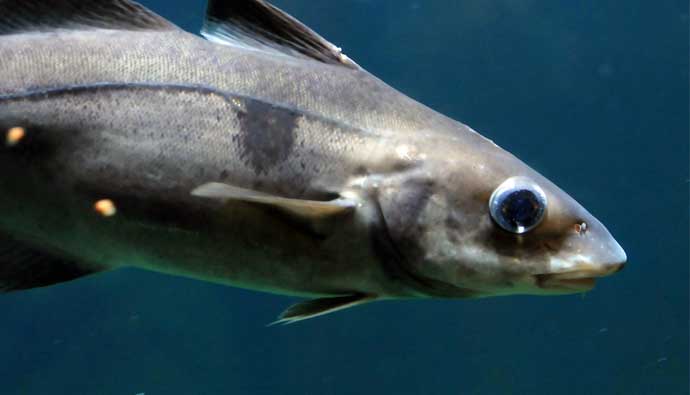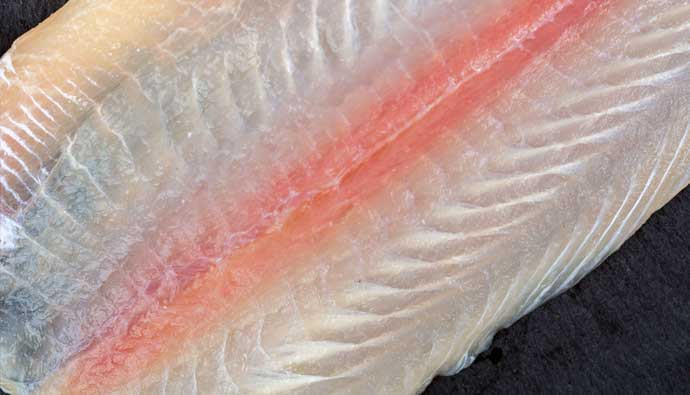Haddock melanogrammus aeglefinus is a fun fish to target by drifting in your boat over some structure.
Whether you’re in the United Kingdom, Gulf of Maine, Georges Bank, or your local watering hole, this haddock fishing should be on your goal. Plus, if you’ve seen the recipes for haddock, you already know it’s a solid table fish.

Let’s figure out how to catch the big ones!
Recommended Fishing Gear:
- Rod: Penn Carnage II
- Reel: Daiwa Saltist
- Tackle: 2/0 Circle Hook
Overview
Haddock has a long and tapered body that is common in fish that belong to the cod family. The mouth is small and it has a wedge-shaped profile. What really makes this fish stand out is the ’Devil’s Thumbprint’ a dark blotch that lies above the pectoral fin, and it also has a small barbell under the chin. This important food fish can be found in the North Atlantic Ocean, Gulf of Maine, and fisheries in northern Europe.
Also known as finnan haddie and scrod haddock, it is a fast-growing fish that can grow from 1 to 3 feet long at maturity and can live for 10 years or more. It doesn’t weigh more than 2 or 7 pounds fully grown.
Haddock Facts
| Scientific Name | Melanogrammus aeglefinus |
| Common Name(s) | Haddock |
| Family | Gadidae |
| Identifying Characteristics | What really makes this fish stand out is the ’Devil’s Thumbprint’ a dark blotch that lies above the pectoral fin, and it also has a small barbell under the chin |
| Depth Range | 50 to 300 m |
| Habitat | It can be found in the North Atlantic Ocean and in fisheries in northern Europe |
| Limits | Check your local regulations |
| Largest Recorded | 44 inches and 37 pounds |
Where to Catch Haddock
As a demersal species, it can be found swimming over rocky or shell-filled substrates, and juveniles prefer to remain near shore in shallow water. Both migrate seasonally as water temperatures shift. They move to deeper water when the water turns cold near the surface in winter.
Many anglers have success finding structures such as rocks or shipwrecks and then drifting over them with live bait.
How to Catch Haddock

Haddock melanogrammus aeglefinus have small mouths and feed mostly on invertebrates and smaller fish. The best way to fish for them is with bait such as clams, but small jigs can also be effective, especially if you are swimming in the shallows.
These won’t attract dogfish either, which may try and steal bait before they have the chance to get at it. Plus, since you will be trying to catch a fish that is sucking bait from the bottom, make sure your line touches the seafloor. Otherwise, they will just swim underneath it and snatch it off.
If you decide to use bait, use shellfish, ragworms or lugworms, or fish such as mackerel, herring, or even starfish. Fish close to the bottom of deep water off steep beaches or rocky outcrops where haddock shoals sift through soft sand in search of food.
If you use a live baitfish, just place the hook through the nose with the hook point facing upwards.
Fishing Tactics
- Haddock shoals are constantly moving, so if you find yourself fishing from reefs or rocks, follow them at the same speed they are swimming in.
- They are light in weight, so you can catch quite a lot with light gear and prevent fatigue from setting in.
Fishing Tips
- Haddock are most common around the coasts of Scotland, North-Eastern parts of England, and deep water that is off the West Country.
- Use jigs instead of single hooks, as trebles can damage small fish easily.
- You’ll want to keep your baits on the bottom, so give yourself plenty of slack in the line and let your boat drift away.
Haddock Seasons
Haddock fish can be found year-round, but it is more abundant in some spots than others. Summer and early Spring are considered the best times to fish for it, especially in March and April when it is spawning. In some areas, the fish can be found in abundance in early June, but it usually swims to deeper water at that time.
How to Clean Haddock

Before we jump into some haddock recipes, let’s first prepare the fish.
- Place a fresh haddock on a cutting board and start at the tail cut along the top of the fish along the dorsal fins using sharp movements. Make sure the knife is sharp enough that you don’t need to see through the delicate flesh.
- Keep cutting till the knife comes out from the base of the tail. Then cut along the head toward the belly till you can open up the fish exposing its rib cage.
- Cut along the fillet above the rib cage to remove it.
- Flip the fish and repeat on the other side.
How to Cook Haddock
Now that we have clean haddock fillets, let’s use the following recipe for haddock to bring some smiles to your dinner table. As with any cod family fish, you know for sure the finnan haddie will deliver a delicious meal.
Haddock Recipe
- Poach fresh haddock in a large pan till the meat is flaky, and save some of the water once done.
- Melt 3 tablespoons of butter in the flour and add a mixture of half a cup of milk and the reserved poaching water gradually while stirring to make a thick sauce.
- Add half a pound of cheddar cheese chunks and heat the pan till the cheese melts.
- Grease up a casserole dish and add layers of fish and cheese sauce and make sure you end with the sauce.
- Pop in a preheated (350°) oven and bake for 30 minutes or till done.
- Serve with cooked sweet potatoes.
Frequently Asked Questions
Yes, the haddock is among the best table fish to eat because of its high protein, low calorie, and low mercury content.
Cod has a more mild flavor, whereas haddock has a richer, more pronounced “fish” taste. The texture of cod is thicker and firmer.
Big, orange teasers are considered to be the best when it comes to catching haddock since these can be tied with circle hooks that won’t snag smaller fish.
If you are drifting bait to catch haddock, chances are you will have difficulty touching the bottom. Use a braided line so that you can feel the instant when your line touches the seafloor, and as you are drifting, leave the reel in free spool, making sure your thumb is on the spool. Then let out the line slowly while keeping it taut. When a haddock bites, let out some more of the line and then lock in the reel to set the hook.
Insider Advice
Haddock is an excellent table fish, and since it travels in large, dense shoals, you shouldn’t have difficulty catching a few, even as a novice.




 Facebook
Facebook YouTube
YouTube









